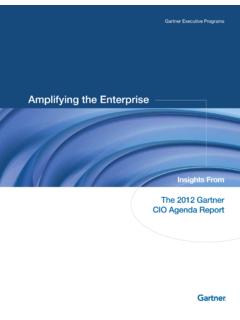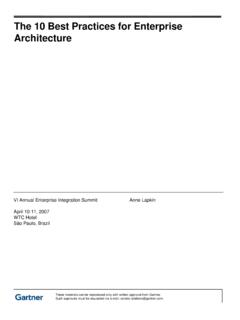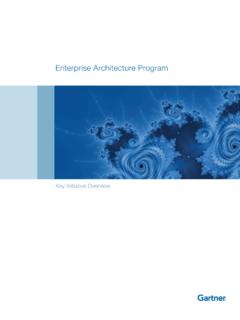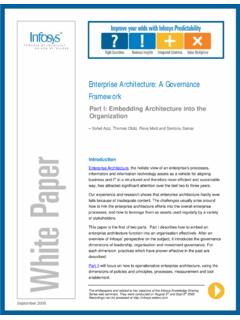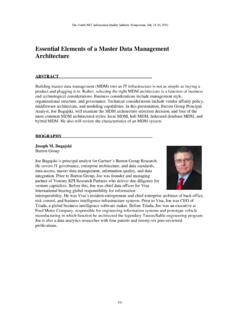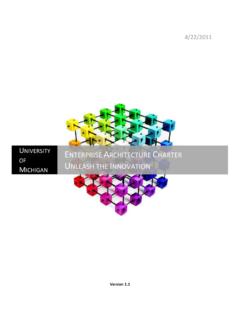Transcription of ACM Tech Pack on Enterprise Architecture - Technion
1 ACM Tech Pack on Enterprise Architecture Brian H. Cameron, Pennsylvania State University Executive Director, Center for Enterprise Architecture College of Information Sciences and Technology Copyright ACM 2011 Table of Contents Foundational Concepts Organizational Alignment and Enterprise Architecture The Enterprise Architecture "Stack" Planning for Enterprise Architecture The Enterprise Architecture Governance Process Enterprise Architecture Change Management Building and Maintaining Enterprise Architecture Leadership, Decision Making, and Team Formation for Enterprise Architecture Enterprise Architecture Success Factors/Value and Risk Analysis for Enterprise Architecture Comparative Analysis of Popular Enterprise Architecture Frameworks and Methodologies Enterprise Architecture Book Sources Introduction to Enterprise Architecture : Although there is a number of ways to define Enterprise Architecture , the benefits that a successful EA implementation can bring to a company are undeniable.
2 In order to be successful and make proper decisions, organizations need to have access to accurate information and the ability to communicate these elements throughout the Enterprise . Enterprise Architecture is the mechanism that allows organizations to achieve this. By enabling high quality and reliable information, Enterprise Architecture allows organizations to respond to business needs and change more efficiently. By the same notion, this communication allows for a business to plan across its various divisions (most of the time between the IT division and business division). This allows for business stakeholders to understand the impact of complex IT projects on the business and what benefits will be realized. Also, Enterprise Architecture will allow for the standardization of terms for this collaboration between business and IT. By being able to provide a common language in which business and IT can communicate, EA allows for two different, yet influential divisions to work together.
3 Historically, the benefits of EA have been seen in the IT field. This is due to its technical origins. With this, EA has been associated primarily with efficiency in the sense of cost reduction. As EA has evolved into a business process, the expectations of EA have evolved as well. The following list of topics is organized into the various fundamentals of Enterprise Architecture . Each section is prefaced with a basic description as well as the purpose of each topic. FOUNDATIONAL CONCEPTS Enterprise Architecture has become a popular topic in recent years and has become a critical component for organizations in a variety of different industries. The value and benefits an EA implementation can bring to an organization is great; however, it takes an extended period of time to realize these achievements. Therefore, it is imperative to have the ability to properly convey the meaning of EA to the necessary parties/stakeholders.
4 In order to create this business case, an understanding of basic foundational concepts is required. gartner Clarifies the Definition of the Term Enterprise Architecture ' Anne Lapkin, Philip Allega, Brian Burke, Betsy Burton, R. Scott Bittler, Robert A. Handler, Greta A. James, Bruce Robertson, David Newman, Deborah Weiss, Richard Buchanan, Nicholas Gall. 12 August 2008. gartner Clarifies the Definition of the Term Enterprise Architecture '. gartner Research. Abstract: gartner clarifies their definition of Enterprise Architecture . In defining Enterprise Architecture as a process, this article summarizes the difference between EA as a verb and a noun, the role of the architect and the overall process of EA, and finally, the various outputs an Enterprise Architecture should produce. Importance: Illustrates an accepted definition of the Enterprise Architecture concept.
5 By doing this, the article looks to reduce conflict over the definition of EA and provide a common understanding that enables organizations. Why Do Enterprise Architecture ? Robertson, Bruce. 12 August 2009. Why do Enterprise Architecture ? gartner Research. Abstract: gartner proposes a number of different approaches that can be used to justify the need for Enterprise Architecture . The overall goal is to illustrate the benefits of EA and also differentiate the process from other planning efforts. In order to achieve this, stakeholder understanding and buy in is necessary. Importance: Provides a number of ways to resonate the concept of EA with a wide range of stakeholders. The article suggests using simple approaches to proposing Enterprise Architecture instead of historical complex attempts that overwhelmed stakeholders. An Integrated View on Business and IT Architecture Rohloff, Michael.
6 2008. An Integrated View on Business and IT Architecture . Proceedings of the 2010 ACM Symposium on Applied Computing. pg. 561 565. DOI= Abstract: The paper outlines the domains of Enterprise Architecture and fundamental design techniques. The consolidation of Architecture description to three basic views is proposed. The component view describes the elements of Architecture and their relationships. The communication view shows how the elements interact with one another. The distribution view describes how the elements are distributed in terms of location or organizational assignment. Key element of Architecture design is to account for interdependencies among the building blocks of Architecture . Blueprints are introduced as a means in planning the deployment of Architecture on a large scale. They give a comprehensive view on the building blocks and how the interact.
7 Blueprints show the effects of Architecture design between business , application , and infrastructure Architecture , thus providing an integrated view on Architecture . The techniques introduced for Architecture design are illustrated by using a selection of real life examples from an Architecture design project. Importance: Discusses the importance of design views as well as the basic EA concepts that are captured by the various design views. ORGANIZATIONAL ALIGNMENT AND Enterprise Architecture Historically, each business function that comprises an organization (marketing, accounting, finance, etc.) actively contributes to the flow of information. This information is then used for decision making that can ultimately impact the organization as a whole. With information being needed within an organization as well as externally, it is imperative for architects to create a solution that will be able to facilitate business needs but at the same time be able to adapt to the market and meet future needs of the organization as well.
8 This type of alignment of IT with business has been sought after for an extended period of time. Enterprise Architecture is the tool that can make this type of organizational alignment a reality. Through EA methodologies and tools, strategic organizational alignment can become a reality. Information Systems Strategy: Reconceptualization, Measurement, and Implications Chen, Daniel Q., Mocker, Martin, Preston, David S., Teubner, Alexander. June 2010. Information Systems Strategy: Reconceptualization, Measurement, and Implications. MIS Quarterly. Accessed on June 20, 2011. Abstract: Information systems strategy is of central importance to IS practice and research. Our extensive review of the literature suggests that the concept of IS strategy is a term that is used readily; however, it is also a term that is not fully understood. In this study, we follow a perspective paradigm based on the strategic management literature to define IS strategy as an organizational perspective on the investment in, deployment, use, and management of IS.
9 Through a systematic literature search, we identify the following three conceptions of IS strategy employed implicitly in 48 articles published in leading IS journals that focus on the construct of IS strategy: (1) IS strategy as the use of IS to support business strategy; (2) IS strategy as the master plan of the IS function; and (3) IS strategy as the shared view of the IS role within the organization. We find the third conception best fits our definition of IS strategy. As such, we consequently propose to operationalize IS strategy as the degree to which the organization has a shared perspective to seek innovation through IS. Specifically, our proposed IS strategic typology suggests an organization's IS strategy falls into one of the two defined categories ( , IS innovator or IS conservative) or is simply undefined. We also develop measures for this new typology.
10 We argue that the proposed instrument, which was cross validated across both chief information officers and senior business executives, has the potential to serve as a diagnostic tool through which the organization can directly assess its IS strategy. We contend that our reconceptualization and operationalization of IS strategy provides theoretical and practical implications that advance the current level of understanding of IS strategy from extant studies within three predominant literature streams: strategic IS planning, IS/business strategic alignment, and competitive use of IS. Importance: This article discusses the concept of strategic alignment in the context of information systems. Through this context, the reader is able to gain a basic understanding of strategic alignment as well as relevant organizational and systems theory. How Enterprise architectures can support integration Anaya, Victor, Ortiz, Angel.
